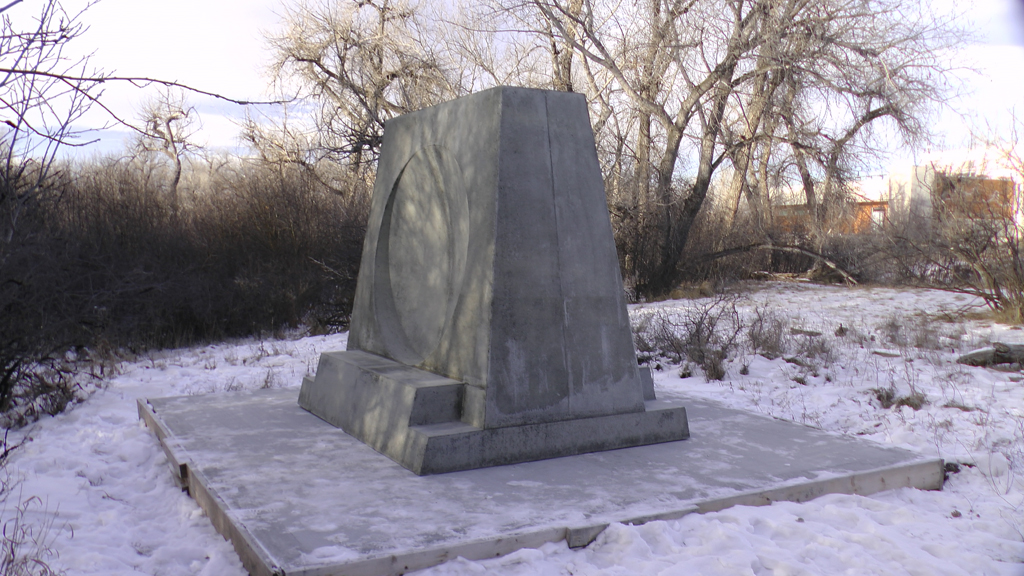Public Works
Listen 2016 – present
The public artwork, Listen, is designed to help visitors to Lethbridge’s Helen Schuler Nature Centre enjoy the park’s acoustic ecology – the relationship between living beings and their environment, understood through sound.
Listen is a sound mirror. The concave area behind the bench is a parabola that reflects sound to a single point 76 cm. or 30 in. from the top of the bench. As a passive hearing aid, Listen does not create sound, but will amplify the sounds entering the parabola for a listener who finds this focus with their ear.
With every visit to Listen, the soundscape will likely be different. This might be because different animals, insects and birds are nearby, or because a change in wind or weather has shaped or carried sound differently. Repeated attention to the park’s soundscape can enhance appreciation of how sound adds a rich, complex and often beautiful dimension to the entire environment.
This seasonal series of guides offers suggestions to help enhance your appreciation of the soundscape:
Haunt (Revisited) 2014
Haunt (Revisited) Documentation from Terry Billings on Vimeo.
Haunt (Revisited) is a looped projection, on urban architecture, of moving images of Saskatoon’s endemic landscapes, and plant and animal life, mostly from a grassland area that has since disappeared under city expansion. In this play of image and architecture, the past environment re-inhabits the current space, reflecting the fleeting nature of memory when confronted with physical change and the shifting values surrounding development. This is documentation at Saskatoon’s 2014 Nuit Blanche Festival. The talking and music in the audio are ambient. The work itself is silent.
Tender 2007-2010
“Tender is a new video work projected onto four vertical windows of the Travel Resource Reading Room of the Frances Morrison Public Library in the downtown area. This subtle intervention mediates between nature and the built environment by superimposing onto the reflective surface of the architecture images of non-urban landscapes, plant and animals which will interact with images of passing cars and pedestrians. Carefully edited single and conjoined images will move from panel to panel as a contemporary equivalent of a shoji screen. There is a double irony in this location: it serves as a reminder to both potential vacationers of the rich bio-diversity of our own region, and as an inspiration to civic politicians, planners and all those who are engaged across the street at City hall in determining the future ecological foot print of Saskatoon.”
Bruce Russell, aneco publication, 2007
Tender Documentation Excerpts 01 from Terry Billings on Vimeo.
Level 2004
 “In a video projection on the north window of the former Roset by Reid jewellery store, Billings sought to achieve a reciprocity between the luminosity of the projected image and the reflections of the street on the window…As the summer sun set, the window became suffused with a glowing, layered montage of projected images of sandhill cranes in the landscape, reflected images of street life, and the shadows that mysteriously blended and dissolved into each other. The audio component consisted of a repeating CD of bird songs Billings had recorded, manipulated and layered played through a speaker above the main entrance to Bayside. During the day, the audio created pockets of lyrical punctuation weaving in and out of the sounds of traffic and the din of the Bay Parkade demolition, often startling pedestrians.During the evening, the audio further interacted with the projected images on the window, referencing the symbiotic connection between image and sound. The work simulated the flux, beauty and interconnectedness of nature and culture, a reminder of the integral unity between humans and natural systems; but at the same time, it pointed to the separations imposed between the two.”
“In a video projection on the north window of the former Roset by Reid jewellery store, Billings sought to achieve a reciprocity between the luminosity of the projected image and the reflections of the street on the window…As the summer sun set, the window became suffused with a glowing, layered montage of projected images of sandhill cranes in the landscape, reflected images of street life, and the shadows that mysteriously blended and dissolved into each other. The audio component consisted of a repeating CD of bird songs Billings had recorded, manipulated and layered played through a speaker above the main entrance to Bayside. During the day, the audio created pockets of lyrical punctuation weaving in and out of the sounds of traffic and the din of the Bay Parkade demolition, often startling pedestrians.During the evening, the audio further interacted with the projected images on the window, referencing the symbiotic connection between image and sound. The work simulated the flux, beauty and interconnectedness of nature and culture, a reminder of the integral unity between humans and natural systems; but at the same time, it pointed to the separations imposed between the two.”
Dan Ring, Spectre publication, 2004
Level Documentation Excerpts from Terry Billings on Vimeo.
Haunt (A Forgotten History) 2002
Haunt was a public video projection in five parts. Moving images of grassland plants and animals were projected on houses in three different areas of Saskatoon on five separate nights. Each program consisted of a 10-minute video sequence that looped for an hour. The projections invoked the city’s hidden history as grassland. Haunt was created for Spasm, a public art works program organized by Paved Art and New Media, Saskatoon.
“Haunt…was appropriately titled as it was the most uncanny work in the show. Selecting three predominantly white houses in Saskatoon, she projected a video loop of relatively untouched southern Saskatchewan landscape on their exteriors on rotating evenings. While the most striking was on a Spanish-inflected Art Deco bungalow in the downtown core, the stucco being a marvelously reflective surface, the most poignant was on a suburban tract home. Close to the edge of the city, you were more aware of the changes to the landscape that European settlers had wrought.”
Andy Fabo, Spasm publication, 2002



